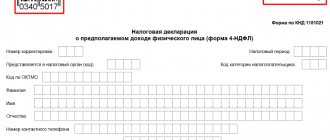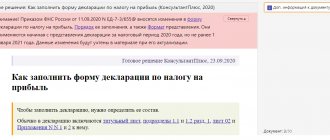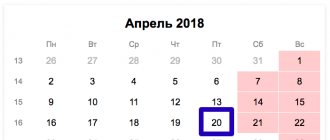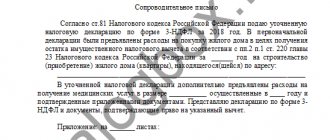3-NDFL (form according to KND 1151020) - tax return form for personal income tax. Using this document, taxpayers report the amount of income they receive and related expenses. A tax return is filled out in the form approved by order of the Federal Tax Service of Russia dated December 24, 2014 No. ММВ-7-11/ [email protected] (as amended on October 10, 2016).
Every year the tax return form is subject to adjustments. Therefore, if you want to download form 3-NDFL, keep in mind that you must fill out a declaration approved in the calendar year for which you are reporting.
How to fill out
The form and explanations for filling it out were approved by the Order of the Federal Tax Service of the Russian Federation dated December 24, 2014. There are two filling options:
- on paper, or handwritten (use only black and blue ink);
- on electronic media. Programs for generating reports can be found on the official tax website. You can fill out forms online in your taxpayer’s personal account.
These services are free, but you may need outside help to create the form because you need to know what information to enter. We'll tell you how to fill out the form yourself and what difficulties may arise.
Title page
Everything here is quite simple, all information about the payer is taken from the relevant documents, the codes are listed in the appendices.
If the declaration is submitted for the first time, the adjustment number is not entered, that is, simply 000 is entered. If the second time, in connection with changes, it is 001. Codes of the tax period for which the citizen is reporting:
- year - 34;
- first quarter - 21;
- second (half-year) - 31;
- nine months - 33.
The tax code can be easily found on the website of the Federal Tax Service of the Russian Federation. Ordinary citizens enter 760 in the “Taxpayer Code” column, individual entrepreneur - 720. The code designation of the passport of a citizen of the Russian Federation is 21. Signature and date are required.
Additional documents required to file your 2021 tax return
To submit a 3-NDFL tax return, you may need the following documents:
- Application for deferment (installment plan) of payment of tax, fee, duty
- Application for personal income tax refund (approved by Letter of the Federal Tax Service dated November 22, 2012 No. ED-4-3/ [email protected] )
- Application for distribution of property tax deduction between spouses (approved by Letter of the Federal Tax Service dated November 22, 2012 No. ED-4-3 / [email protected] )
The article was written and posted on January 9, 2021. Added - 10/05/2016, 11/18/2016, 12/10/2016, 12/25/2016, 09/05/2017, 12/19/2017, 01/10/2018, 01/30/2018, 09/26/2018, 10/18/2018, 10/28/2019, 09/19/2020
ATTENTION!
Copying the article without providing a direct link is prohibited. Changes to the article are possible only with the permission of the author.
Author: lawyer and tax consultant Alexander Shmelev © 2001 — 2021
Section 1
This is a small sheet; in column 010 you must enter the necessary numbers that determine the obligation to pay the fee: 1 means tax, 2 means refund from the budget, 3 means no tax.
Line 020 indicates the KBK of the tax, 030 - OKTMO (data can be found on the tax website) of the municipality, 040 - the amount, 050 - zero. If there is an overpayment, then a zero is entered in column 040, and 050 is the refund amount. If there is no fee, zeros are placed in familiar places 040 and 050.
KND form 1151020 “Tax return for personal income tax” (form 3-NDFL)
General requirements
The personal income tax return form (hereinafter referred to as the Declaration) on paper must be filled out by hand or printed on a printer using blue or black ink.
Double-sided printing of the Declaration on paper is not allowed. The Declaration can be prepared using software that provides for the display of a two-dimensional barcode on the pages of the Declaration when printing the Declaration.
Corrections to the Declaration are not permitted.
Deformation of barcodes and loss of information on Declaration sheets when using mechanical office supplies to fasten Declaration sheets is not allowed.
When filling out the Declaration form, the values of indicators are used from certificates of income and withheld amounts of taxes issued by tax agents at the request of the taxpayer, settlement, payment and other documents available to the taxpayer, as well as from calculations made on the basis of these documents.
Each indicator corresponds to one field in the Declaration form, consisting of a certain number of cells. Each indicator is recorded in one field.
The exceptions are indicators whose values are date, proper fraction or decimal, as well as indicators whose unit of measurement is monetary units.
A proper or decimal fraction corresponds to two fields separated by either a “/” (“slash”) or a “.” (“dot”) respectively. The first field corresponds to the numerator of the proper fraction (the whole part of the decimal), the second - to the denominator of the proper fraction (the fractional part of the decimal).
Indicators expressed in monetary units are indicated in a similar manner. The first field indicates the value of the indicator, consisting of whole monetary units, the second - from a part of the corresponding monetary unit.
To indicate the date, three fields are used in order: day (field of two cells), month (field of two cells) and year (field of four cells), separated by a dot.
All cost indicators are indicated in the Declaration in rubles and kopecks, with the exception of amounts of income from sources outside the territory of the Russian Federation, before their conversion into the currency of the Russian Federation.
Amounts of personal income tax (hereinafter referred to as tax) are calculated and indicated in full rubles. Values of indicators for tax amounts of less than 50 kopecks are discarded, and amounts of 50 kopecks or more are rounded to the full ruble.
The taxpayer's income, as well as expenses accepted for deduction, expressed in foreign currency, are recalculated into rubles at the rate of the Central Bank of the Russian Federation established on the date of actual receipt of income or on the date of actual expenditure.
The text fields of the Declaration form are filled in from left to right, starting from the leftmost cell, or from the left edge of the field reserved for recording the value of the indicator.
In the indicator field “Code according to OKCode according to OKCode according to OK12445698—“.
At the top of each completed page of the Declaration form, the taxpayer identification number (hereinafter referred to as TIN), as well as the surname and initials of the taxpayer in capital letters, are indicated. A taxpayer who is not an individual entrepreneur has the right not to indicate the TIN in the Declaration submitted to the tax authority, provided that he indicates on the title page of the Declaration the data provided for in subparagraphs 4 and 7 of paragraph 3.2 of this Procedure.
At the bottom of each completed page of the Declaration form, with the exception of page 001 of the Title Page, in the field “I confirm the accuracy and completeness of the information specified on this page,” the signature of the taxpayer or his representative, as well as the date of signing, are affixed.
Filling out the Declaration form without using software is carried out taking into account the following.
- Filling out the numeric fields of the Declaration form is carried out in capital printed characters from left to right.
- If any indicator is missing, a dash is placed in all cells of the corresponding field. If to indicate any indicator it is not necessary to fill out all the cells of the corresponding field, a dash is placed in the unfilled cells on the right side of the field. For example, when specifying the ten-digit TIN of an organization “5024002119” in the TIN field of twelve cells, the indicator is filled in as follows: “5024002119—“.
- Fractional numeric indicators are filled in similarly to the rules for filling in integer numeric indicators. If there are more cells for indicating the fractional part than numbers, then a dash is placed in the free cells of the corresponding field. For example, if the indicator “Share(s)
- If the information to be reflected in the Declaration does not fit on one page of the Sheet intended to reflect them, then the required number of pages of the corresponding Sheet is filled out. The final results in this case are reflected only on the last added page.
Completion and submission of the Declaration prepared using the software is subject to the following.
- The values of numerical indicators are aligned to the right (last) familiarity.
- When printing on a printer, it is allowed that there is no border around cells or dashes for unfilled cells. Signs must be printed in Courier New font with a height of 16 - 18 points.
After filling out and completing the Declaration form, the taxpayer must enter the continuous numbering of the completed pages in the “Page” field.
The page number indicator (field “Page”), which has three cells, is written as follows. For example, for the first page - “001”; for the fifteenth - “015”.
A copy of the document confirming the authority of the legal or authorized representative of the taxpayer to sign the submitted Declaration must be attached to the Declaration.
The taxpayer or his representative has the right to draw up and attach to the Declaration a register of documents attached to the Declaration and confirming the information specified in the sections and appendices of the Declaration.
Filling out the title page
The title page is filled out by the taxpayer (taxpayer’s representative), except for the section “To be filled out by a tax authority employee.”
When filling out the Title Page, indicate:
1) tax period (code) and reporting year - indicate the code of the tax period and the calendar year for which the Declaration is submitted:
- tax period code “34” - in case the taxpayer submits a Declaration for a calendar year,
- tax period code “86” - if the taxpayer submits a Declaration in accordance with paragraph 3 of Article 229 of the Code;
2) correction number.
- When submitting to the tax authority an initial Declaration filled out without the use of software, the “adjustment number” detail is entered “0—“; when submitting an updated Declaration filled out without the use of software, the “adjustment number” is indicated, reflecting which of the updated Declarations submitted to the tax authority (for example, “1—”, “2—” and so on).
- If the taxpayer discovers in the Declaration submitted to the tax authority that information is not reflected or is incompletely reflected, as well as errors leading to an underestimation of the amount of tax payable, the taxpayer is obliged to make the necessary changes to the Declaration and submit an updated Declaration to the tax authority in the manner prescribed by Article 81 Code.
- If the taxpayer discovers inaccurate information in the Declaration submitted to the tax authority, as well as errors that do not lead to an understatement of the amount of tax payable, the taxpayer has the right to make the necessary changes to the Declaration and submit an updated Declaration to the tax authority in the manner prescribed by Article 81 of the Code.
- The updated Declaration is submitted to the tax authority in the form that was in force during the tax period for which the corresponding changes are made.
- When recalculating the tax base and tax amount, the results of tax audits conducted by the tax authority for the tax period for which the tax base and tax amount are recalculated are not taken into account.
3) is submitted to the tax authority (code) - the code of the tax authority at the place of residence in the Russian Federation is indicated (in the absence of a place of residence in the Russian Federation - the code of the tax authority for registration at the place of residence) of the taxpayer to which the Declaration is submitted;
4) country code - indicate the numeric code of the country of which the taxpayer is a citizen. The country code is indicated in accordance with the All-Russian Classifier of World Countries OK (hereinafter referred to as OKSM). If the taxpayer does not have citizenship, the code of the country that issued the document proving his identity is indicated in the “Country Code” field;
5) taxpayer category code - indicate the code of the category to which the taxpayer belongs, in respect of whose income the Declaration is being submitted, in accordance with Appendix No. 1 to this Procedure;
6) last name, first name, patronymic (hereinafter the patronymic is indicated if available) of the taxpayer in full, without abbreviations, in accordance with the taxpayer’s identity document. For foreign individuals, it is allowed to use letters of the Latin alphabet when writing their last name, first name and patronymic;
7) personal data of the taxpayer:
7.1) date of birth (day, month, year in numbers in the format DD.MM.YYYY) and place of birth - in accordance with the entry in the taxpayer’s identity document;
7.2) information about the taxpayer’s identity document:
- the code of the type of document certifying the taxpayer’s identity is filled out in accordance with Appendix No. 2 to this Procedure;
- series and number - the details (series and number) of the identity document of an individual are indicated, the sign “N” is not indicated, the series and number of the document are separated by the sign “” (“space”);
- issued by - the name (abbreviated name) of the body that issued the document certifying the identity of an individual is indicated;
- date of issue - indicates the date of issue of the identity document of an individual (in numbers day, month, year in the format DD.MM.YYYY).
- Personal data may not be indicated if the taxpayer indicates his TIN in the Declaration submitted to the tax authority;
 taxpayer status code. Taxpayer status is determined in accordance with the provisions of Article 207 of the Code. If you have the status of a tax resident of the Russian Federation, enter 1 in the corresponding field; if you do not have such status, enter 2;
taxpayer status code. Taxpayer status is determined in accordance with the provisions of Article 207 of the Code. If you have the status of a tax resident of the Russian Federation, enter 1 in the corresponding field; if you do not have such status, enter 2;
9) contact phone number. The telephone number of the taxpayer or his representative with the country telephone code (for individuals living outside the Russian Federation) and other telephone codes required to provide telephone communication is indicated. The telephone number is indicated in the following format: “8”, code, number; between “8” and the code, as well as between the code and the number, the sign “ ” (“space”) is indicated (for example: 8 903 4567890);
10) the number of pages on which the Declaration is drawn up;
11) the number of sheets of supporting documents or their copies, including a copy of the document confirming the authority of the taxpayer’s representative to sign the Declaration, attached to the Declaration;
12) in the section of the Title page “I confirm the accuracy and completeness of the information specified in this Declaration”, the necessary information is filled in in the following order:
- a) if the accuracy and completeness of the information is confirmed by the taxpayer himself, 1 is entered in the field consisting of one cell; if the accuracy and completeness of the information is confirmed by a representative of the taxpayer - 2;
- b) if the accuracy and completeness of the information is confirmed by the taxpayer himself, his personal signature is affixed in the place reserved for signature, as well as the date of signing the Declaration (in numbers the day, month, year in the format DD.MM.YYYY);
- c) if the accuracy and completeness of the information is confirmed by the taxpayer’s representative - an organization, then in the field “(last name, first name, patronymic <*> representative of the taxpayer)” the last name, first name, patronymic of the general director of the organization - the taxpayer’s representative is indicated in accordance with the constituent documents and a signature is affixed authorized person, as well as the date of signing (day, month, year in numbers in the format DD.MM.YYYY);
- d) if the accuracy and completeness of the information is confirmed by the taxpayer’s representative - an individual, then in the field “(last name, first name, patronymic <*> representative of the taxpayer)” the last name, first name, patronymic of the taxpayer’s representative are indicated in accordance with the identity document, and the personal signature of the taxpayer’s representative, as well as the date of signing (day, month, year in numbers in the format DD.MM.YYYY);
- e) in the field “Name and details of the document confirming the authority of the taxpayer’s representative” indicate the name and details of the document confirming the authority of the taxpayer’s representative;
13) the section of the title page “To be completed by an employee of the tax authority” contains information about the code for the method of submitting the Declaration, the number of pages of the Declaration, the number of sheets of supporting documents or their copies attached to the Declaration, the date of its submission (reception), the number under which the Declaration is registered, surname and the initials of the name and patronymic (if any) of the tax authority employee who accepted the Declaration, his signature.
Filling out Section 1 “Information on the amounts of tax subject to payment (addition) to the budget/refund from the budget”
Section 1, which reflects the amount of tax subject to payment (surcharge) to the budget or refund from the budget, is filled out after filling out the required number of Sections 2 of the Declaration form based on the calculations made in Sections 2.
If, based on the results of calculations, the amounts subject to refund from the budget were determined for the tax that was paid (withheld) in various administrative-territorial entities, as well as in the case of determining the amounts of tax subject to payment (surcharge) for different codes (refunds from different codes) of the budget classification of budget tax revenues, Section 1 is filled out separately for each OKTMO code and code of the budget classification of budget tax revenues, respectively. That is, several Sections 1 can be filled out with different OKTMO codes or budget classification codes for budget tax revenues.
In line 010 of Section 1 the following is entered: 1 - if, based on the results of calculations, the amounts of tax to be paid (additionally) to the budget have been determined, 2 - amounts of tax to be refunded from the budget, 3 - if there are no amounts of tax to be paid (additionally) to the budget or refund from the budget.
If, based on the results of calculations, the amounts of tax to be paid (additional payment) to the budget are determined, when filling out Section 1, indicate:
- in line 020 - code of the budget classification of tax revenues of budgets, according to which the amount of tax to be paid (surcharge) to the budget should be credited;
- in line 030 - OKTMO code of the municipality at the place of residence (place of registration), on the territory of which the tax is paid (surcharge);
- in line 040 - the total amount of tax to be paid (surcharge) to the budget;
- in line 050 a zero is entered.
If, based on the results of calculations, the amounts of overpaid tax are determined (there is an amount of tax that is subject to refund from the budget), when filling out Section 1, indicate:
- in line 020 - the code of the budget classification of tax revenues, according to which the tax amount should be refunded from the budget;
- in line 030 - the OKTMO code of the municipal entity at the place of residence (place of registration) of the taxpayer, on the territory of which the tax was paid, the overpayment of which is subject to refund from the budget on the basis of the Declaration (if the tax was withheld by a tax agent, then the OKTMO code is filled in from the information about income of an individual (form 2-NDFL));
- in line 040 a zero is entered;
- in line 050 - the total amount of tax to be refunded from the budget.
If the results of the calculations did not reveal the amounts of tax subject to payment (addition) to the budget or refund from the budget, when filling out Section 1, indicate:
- in line 020 - code of the budget classification of tax revenues of budgets, corresponding to the type of tax income for which no amounts of tax were identified that were subject to payment (addition) to the budget or refund from the budget;
- in line 030 - OKTMO code of the municipality at the place of residence (place of registration) of the taxpayer;
- in lines 040 and 050 a zero is entered.
Completing Section 2 “Calculation of the tax base and the amount of tax on income taxed at the rate of (001)__percent”
In Section 2, taxpayers calculate the total amount of income subject to taxation, the tax base and the amount of tax subject to payment (addition) to the budget or refund from the budget, based on income taxed at the rate specified in indicator field 001 of Section 2.
If the taxpayer received income taxed at different tax rates during the tax period, then the calculation of the tax base and the amount of tax payable to the budget (refund from the budget) is filled out on a separate sheet for the amount of taxes on income taxed at each tax rate.
Depending on the type of income reflected in the Declaration, the corresponding attribute is entered in indicator field 002 of Section 2 “Type of income”:
- 1 - when reflecting income from equity participation in an organization in the form of dividends;
- 2 - when reflecting income in the form of amounts of profit of controlled foreign companies;
- 3 - when reflecting other income.
The calculation of the tax base, as well as the amount of tax subject to payment (addition) to the budget or refund from the budget, in relation to income from equity participation in an organization in the form of dividends, as well as in relation to income in the form of profits of controlled foreign companies, is carried out on a separate sheet.
The total amount of income, with the exception of income in the form of profits of controlled foreign companies, received by the taxpayer in the tax period for which the Declaration is submitted (line 010), taxed at the rate specified in indicator field 001 of Section 2, is determined by adding the following indicators:
- the amount of income taxed at the appropriate tax rate specified in lines 070 of Appendix 1 (for income received from sources in the Russian Federation);
- the amount of income taxed at the appropriate tax rate specified in lines 070 of Appendix 2 (in case of receiving income from sources outside the Russian Federation);
- the total amount of income from business, advocacy and private practice specified in line 050 of Appendix 3;
- the amount of the previously provided investment tax deduction, subject to restoration, specified in line 220 of Appendix 5.
The total amount of income in the form of dividends is reflected in line 010 separately from other income received in the tax period, and is determined based on the amounts of these types of income taxed at the appropriate tax rate, indicated in lines 070 of Appendix 1 and in lines 070 of Appendix 2.
When filling out this line, the amounts of income in the form of profits of controlled foreign companies are not taken into account.
The total amount of income, excluding income in the form of profits of controlled foreign companies, not subject to taxation (line 020):
- in accordance with paragraphs 60 and 66 of Article 217 of the Code, transferred from lines 071 and 072 of Appendix 2, respectively;
- in accordance with other provisions of Article 217 of the Code is transferred from line 120 of Appendix 4.
The total amount of income, excluding income in the form of profits of controlled foreign companies, subject to taxation (line 030), is calculated by subtracting the indicator on line 020 from the indicator on line 010.
The amount of tax deductions that reduces the tax base (line 040) is determined by adding the values of the following indicators:
- the amount of professional tax deductions provided for in Article 221 of the Code (the sum of the values of the indicators of lines 060 and 150 of Appendix 3);
- the amount of standard and social tax deductions provided for in Articles 218 and 219 of the Code, as well as the amount of investment tax deduction provided for in subparagraph 2 of paragraph 1 of Article 219.1 of the Code (the sum of the values of the indicators of lines 070, 181, 200 and 210 of Appendix 5);
- the amount of property tax deductions for income from the sale of property (property rights), from the seizure of property (property rights) for state or municipal needs, as well as the amount of tax deductions for the sale of shares in the authorized capital and for the assignment of the right of claim under an agreement for participation in shared construction, provided for in Article 220 of the Code (line 160 of Appendix 6);
- the amount of property tax deductions for expenses incurred on new construction or acquisition of property provided for in Article 220 of the Code (the sum of the values of indicators in lines 120, 130, 150 and 160 of Appendix 7);
- the amount of investment tax deduction provided for in subparagraph 1 of paragraph 1 of Article 219.1 of the Code, accepted for deduction for the totality of transactions performed (indicator on line 060 of Appendix 8);
- the amount of investment tax deduction provided for in subparagraph 3 of paragraph 1 of Article 219.1 of the Code, accepted for deduction for the totality of transactions performed (indicator on line 070 of Appendix 8).
If the calculation of the tax base and tax amount is made in relation to income not taxed at a tax rate of 13 percent, then a zero is entered in line 040.
The amount of tax deductions (line 040) and the amount of expenses taken to reduce income received (line 050) in total cannot exceed the value of line 030.
The amount of expenses taken to reduce income received (line 050) is determined by indicating the amount of expenses (losses) for the totality of transactions with securities, derivative financial instruments, including transactions accounted for on an individual investment account in accordance with Articles 214.1, 214.3, 214.4, 214.9 of the Code, as well as transactions performed by the taxpayer as part of participation in investment partnerships (the sum of the values of the indicators of lines 040 and 052 of Appendix 8).
The total amount of income in the form of profits of controlled foreign companies (line 051) is determined based on the amounts of this type of income taxed at the appropriate tax rate specified in lines 070 of Appendix 2.
The tax base is reflected on line 060 and is calculated as the difference between the total amount of income, with the exception of income in the form of profits of controlled foreign companies subject to taxation (line 030), the total amount of income in the form of profits of controlled foreign companies (line 051), and the total the amount of tax deductions (line 040) and expenses taken to reduce income received, reflected on line 050. If the result is negative or equal to zero, then a zero is entered in line 060.
To calculate the amount of tax on income taxed at a certain tax rate, subject to payment (addition) or refund from the budget, the taxpayer indicates:
in line 070 - the total amount of tax calculated for payment, which is determined by multiplying the tax base reflected in line 060 by the corresponding tax rate (in percentage);
in line 080 - the total amount of tax withheld at the source of payment of income, which is determined by adding the amounts of tax withheld at the source of payment of income taxed at a similar tax rate, indicated in lines 080 of Appendix 1;
in line 090 - the total amount of tax withheld at the source of payment of income in accordance with subparagraph 1 of paragraph 1 of Article 212 of the Code, in relation to income in the form of material benefits.
This line is filled in by taxpayers who are tax residents of the Russian Federation who have received from the tax authority confirmation of the right to a property tax deduction for expenses incurred on new construction or acquisition of property provided for in Article 220 of the Code, after the tax on income in the form of material benefits received from savings on interest for the use of borrowed (credit) funds issued for new construction or acquisition on the territory of the Russian Federation of a residential building, apartment, room or share(s) in them, land plots provided for individual housing construction, and land plots for of which the purchased residential buildings are located, or the share(s) in them, was actually withheld by tax agents at a rate of 35 percent.
Line 090 is filled in only when calculating the amount of personal income tax taxed at a rate of 35 percent. If the calculation of the tax base and tax amount is made in relation to income taxed at other tax rates, a zero is entered in this line;
in line 100 - the amount of trade tax paid in the tax period, subject to offset in accordance with the provisions of paragraph 5 of Article 225 of the Code.
In this case, the value of line indicator 100 cannot exceed the value of line indicator 070.
in line 110 - the amount of tax actually paid by the taxpayer for the reporting tax period in the form of advance payments, subject to offset (the value of the indicator is transferred from line 070 of Appendix 3);
in line 120 - the total amount of fixed advance payments paid by the taxpayer, subject to offset in accordance with paragraph 5 of Article 227.1 of the Code, but not more than the amount of tax calculated on the basis of the income actually received by the taxpayer for the tax period from employment for individuals for on the basis of a patent issued in accordance with Federal Law No. 115-FZ of July 25, 2002 “On the legal status of foreign citizens in the Russian Federation” (Collected Legislation of the Russian Federation, 2002, No. 30, Art. 3032; 2021, No. 30, Art. 4551 );
in line 130 - the total amount of tax paid in foreign countries, subject to offset in the Russian Federation (the totality of the values of lines 130 of Appendix 2);
in line 140 - the amount of tax paid in connection with the application of the patent tax system, subject to offset in accordance with the provisions of paragraph 7 of Article 346.45&a
Calculation of mandatory payment
This section raises the most questions in practice. It is necessary to know not only the amount of the base and the fee rate, but also the applicable deductions (listed in special sheets). After determining the base, taking into account deductions, the tax is quite simple to determine.
Filling out other sheets can also be difficult if you have no practice in filling out the declaration. It is necessary to follow the explanations in the form itself and indicate the data strictly in the right places.
It may be easier to understand the program for filling out the form. There are six required fields to fill out:
- Setting conditions.
- Information about the declarant.
- Income.
- Property deduction.
- Standard.
- Social.
All data is also entered in accordance with the documents. But filling out the program is much easier: there are hints, and the information is more concentrated, some data is already entered, for example, the rate is 13%. There are also some features: to receive property deductions, you need to uncheck the “Standard deductions” line, for example, tabs are displayed in the form of pictures (sale of property - house), etc.
Which filling option to choose depends on the declarant himself. If necessary, you can turn to the Federal Tax Service for help (but keep in mind that specialists will not fill out the declaration for a citizen) or to specialists.








